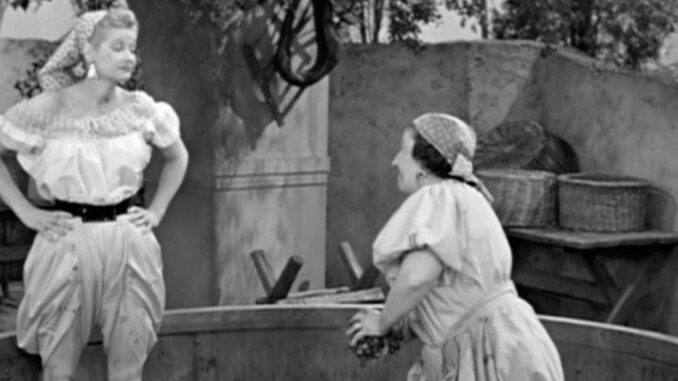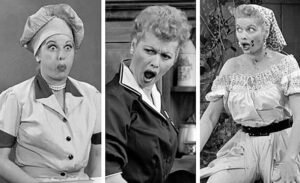
In the golden days of television, few shows left as indelible a mark on pop culture as I Love Lucy. When it debuted on October 15, 1951, I Love Lucy didn’t just make audiences laugh—it redefined what television could be, setting standards that are still referenced by media giants today. But how did this simple sitcom about a quirky housewife become a cultural icon and launch a media legend? This article delves into the pioneering ways I Love Lucy shaped the history of television, carving out a permanent place in the hearts of audiences everywhere.
The Early Days of Television and the Birth of a Classic
Television in the 1950s was still finding its footing, with many studios experimenting to see what worked. But in a time when most TV shows were broadcast live, I Love Lucy brought something innovative to the table—pre-recorded, carefully edited episodes that would ultimately capture the essence of family humor and charm.
Lucy and Desi: A Power Couple Like No Other

At the heart of I Love Lucy was Lucille Ball and Desi Arnaz, both stars and masterminds behind the show. Ball, a comedian who captivated with her slapstick timing, and Arnaz, a musician and producer, weren’t just TV spouses; they were real-life partners. Their chemistry on and off the screen brought authenticity to their roles, making audiences fall in love with them as both characters and individuals.
How Desi’s Vision Changed TV Production Forever
Desi Arnaz wasn’t just the charming husband on-screen—he was a visionary. He insisted on filming I Love Lucy in Hollywood rather than New York, where live shows were typically staged. This move set off a chain reaction, forever changing how television was produced. By filming in front of a live audience with multiple cameras, Arnaz pioneered the “three-camera” technique still in use today.
The Real Reason Behind Filming in Hollywood
While the decision to film in Hollywood was partly practical, it also allowed the team to produce a higher-quality show. Filming with multiple cameras and editing for the best takes gave I Love Lucy an unprecedented polish and set it apart from the competition.
Breaking Down Boundaries With Unconventional Storylines
The 1950s were conservative, but I Love Lucy wasn’t afraid to push boundaries. Lucille Ball’s character, Lucy Ricardo, constantly found herself in hilarious situations that showcased her quirky personality and strong will. These antics broke new ground, moving beyond the submissive housewife stereotype prevalent in other shows of the time.
Lucy’s Pregnancy: A Game-Changer for Network Television
One of the most revolutionary moments in I Love Lucy came when Lucille Ball became pregnant. Rather than hide her condition, the show’s writers worked Lucy’s pregnancy into the storyline, a first in television history. This move was both controversial and groundbreaking, showing viewers that family life on television could reflect real life.
The Famous “Lucy Goes to the Hospital” Episode
This episode, where Lucy is about to deliver her baby, became one of the most-watched TV episodes in history. More than 44 million viewers tuned in—an audience even larger than President Eisenhower’s inauguration. This marked a turning point, proving that television could tackle real-life milestones with humor and grace.
The Three-Camera Technique That Made Sitcoms Look Real

The three-camera technique became an industry standard, but it was almost unheard of before I Love Lucy. By filming the show from three different angles and in front of a live audience, Desi Arnaz and his production team were able to create a genuine comedic atmosphere that captured real-time reactions and emotions, making scenes feel spontaneous and alive.
Why This Technique Changed the Industry Forever
With the three-camera setup, they could edit the best takes, which increased production quality without needing multiple re-shoots. This innovation not only saved time but also set a new industry standard that sitcoms still rely on today.
The Power of Reruns and Syndication: An Unplanned Success
Reruns were almost an afterthought in television until I Love Lucy showed their potential. Desi and Lucy’s ownership of the show’s episodes gave them control, allowing them to re-air episodes and effectively launch the concept of TV syndication.
How “I Love Lucy” Pioneered Reruns
When Lucille Ball took maternity leave, CBS needed new content to fill the gap. So, they decided to re-air previous episodes of I Love Lucy, a decision that not only kept viewers entertained but also introduced the concept of syndicated reruns. This strategy was financially groundbreaking and remains profitable to this day.
The Iconic Moments That Defined an Era
There’s no shortage of unforgettable moments from I Love Lucy. From Lucy’s infamous “Vitameatavegamin” skit to the chaotic grape-stomping scene, these moments became cultural touchstones, symbolizing the golden age of television.
The “Vitameatavegamin” Skit: Comedy Gold
Perhaps one of the most beloved scenes, the “Vitameatavegamin” skit showcases Lucille Ball’s comedic genius. As Lucy struggles through a TV commercial for a tonic that tastes terrible, her expressions and timing make it unforgettable. This scene alone captures her unique talent and is studied by comedians to this day.
Grape-Stomping Scene: Lucy’s Physical Comedy at Its Best
The scene where Lucy finds herself stomping grapes in a vineyard became another classic moment, perfectly illustrating her knack for physical comedy. It’s no wonder why fans return to these iconic scenes, which continue to be referenced in pop culture today.
A Cultural Impact That Echoes Through Time
I Love Lucy didn’t just impact television; it impacted culture. It influenced fashion, slang, and even the perception of marriage and family life on TV.
Redefining Marriage on Television
Before I Love Lucy, married couples on television were often portrayed in overly idealized ways. Lucy and Ricky’s relationship was far from perfect, and they frequently disagreed. But it was their genuine love and respect for each other that resonated with viewers, providing a more realistic portrayal of marriage.
Paving the Way for Future Female Comedians
Lucille Ball’s fearless humor and remarkable timing inspired countless female comedians who came after her. From Carol Burnett to Tina Fey, women in comedy have looked to Ball as a trailblazer who showed that women could be funny, bold, and successful in a male-dominated industry.
The Lasting Influence on Today’s Sitcoms
Sitcoms like Friends, The Office, and Parks and Recreation all owe a debt to I Love Lucy. The show’s format, style, and approach to relatable humor continue to influence modern television, proving that Lucy’s legacy is alive and well.
The Fan Culture That Keeps Lucy’s Legacy Alive
Even decades after it first aired, I Love Lucy boasts a passionate fanbase. From conventions to memorabilia, fans continue to celebrate the show’s legacy.
How Nostalgia Plays a Role in Its Continued Popularity
Nostalgia has fueled I Love Lucy’s staying power. Fans return to the show not just to laugh but to feel the comfort of simpler times, making it a timeless classic.
Conclusion: The Timeless Legacy of “I Love Lucy”
From pioneering new production techniques to breaking down cultural barriers, I Love Lucy was more than just a sitcom; it was a media phenomenon. Lucille Ball and Desi Arnaz created a show that became an essential part of American pop culture, resonating across generations and proving that good comedy never goes out of style. As we look back, it’s clear that I Love Lucy is not just a show from the past—it’s a legend that shaped the future of television.
